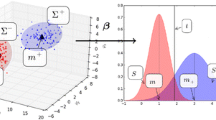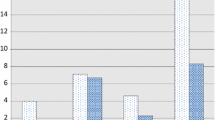Abstract
This paper concerns estimation of generalization performance of the multi-output extreme learning machine classifier (M-ELM) in the framework of statistical learning theory. The performance bound is derived under the assumption that the expectation of the extreme learning machine kernel exists. We first show that minimizing the least square error is equal to minimizing an upper bound of the error concerning the margin of M-ELM in the training set, which implies that M-ELM ends up with high confidence after training. Afterwards, we derive the bound based on the margin of M-ELM and the empirical Rademacher complexity. The bound not only gives a theoretical explanation of good performance of M-ELM especially in the small-sample cases, but also shows that the performance of M-ELM is insensitive to the number of hidden nodes, which is consistent with previous experimental results. The bound also offers an insight that the performance of M-ELM is not significantly affected by the number of classes, which proves the effectiveness of the learning process of M-ELM.
Similar content being viewed by others
Explore related subjects
Discover the latest articles, news and stories from top researchers in related subjects.References
Huang GB, Wang DH, Lan Y (2011) Extreme learning machines: a survey. Int J Mach Learn Cybern 2(2):107–122
Huang G, Huang GB, Song S, You K (2015) Trends in extreme learning machines: a review. Neural Netw 61(C):32–48
Cao J, Zhang K, Luo M, Yin C, Lai X (2016) Extreme learning machine and adaptive sparse representation for image classification. Neural Netw 81(C):91
Kim J, Kim J, Jang GJ, Lee M (2017) Fast learning method for convolutional neural networks using extreme learning machine and its application to lane detection. Neural Netw 87:109–121
Liu H, Li F, Xu X, Sun F (2018) Active object recognition using hierarchical local-receptive-field-based extreme learning machine. Memet Comput 10(2):233–241
Zhang H, Zhang S, Yin Y (2018) Kernel online sequential ELM algorithm with sliding window subject to time-varying environments. Memet Comput 10(1):43–52
Huang GB, Zhu QY, Siew CK (2006) Extreme learning machine: theory and applications. Neurocomputing 70(1–3):489–501
Huang GB, Zhou H, Ding X, Zhang R (2012) Extreme learning machine for regression and multiclass classification. IEEE Trans Syst Man Cybern B Cybern 42(2):513–529
Chorowski J, Wang J, Zurada JM (2014) Review and performance comparison of SVM-and ELM-based classifiers. Neurocomputing 128:507–516
Zhang L, Zhang D (2015) Evolutionary cost-sensitive extreme learning machine. IEEE Trans Neural Netw Learn Syst 28(12):3045–3060
Lei Z, Zhang D (2016) Robust visual knowledge transfer via extreme learning machine-based domain adaptation. IEEE Trans Image Process Publ IEEE Signal Process Soc 25(10):4959–4973
Zhang L, He Z, Liu Y (2017) Deep object recognition across domains based on adaptive extreme learning machine. Neurocomputing 239:194–203
Lu H, Du B, Liu J, Xia H, Yeap WK (2017) A kernel extreme learning machine algorithm based on improved particle swam optimization. Memet Comput 9(2):121–128
Lu C, Ke H, Zhang G, Mei Y, Xu H (2017) An improved weighted extreme learning machine for imbalanced data classification. Memet Comput 1:1–8
Huang GB (2014) An insight into extreme learning machines: random neurons, random features and kernels. Cognit Comput 6(3):376–390
Huang GB (2015) What are extreme learning machines? Filling the gap between Frank Rosenblatts dream and John Von Neumanns puzzle. Cognit Comput 7:263–278
Huang GB, Chen L, Siew CK (2006) Universal approximation using incremental constructive feedforward networks with random hidden nodes. IEEE Trans Neural Netw 17:879–892
Huang GB, Chen L (2007) Convex incremental extreme learning machine. Neurocomputing 70:3056–3062
Liu X, Gao C, Li P (2012) A comparative analysis of support vector machines and extreme learning machines. Neural Netw 33:58–66
Liu X, Lin S, Fang J, Xu Z (2015) Is extreme learning machine feasible? A theoretical assessment (part I). IEEE Trans Neural Netw Learn Syst 26:7–20
Lin S, Liu X, Fang J, Xu Z (2015) Is extreme learning machine feasible? A theoretical assessment (part II). IEEE Trans Neural Netw Learn Syst 26:21–34
Rahimi A, Recht B (2009) Weighted sums of random kitchen sinks: replacing minimization with randomization in learning. In: Advances in neural information processing systems. Curran Associates Inc, Vancouver, pp 1313–1320
Wang D, Wang P, Ji Y (2015) An oscillation bound of the generalization performance of extreme learning machine and corresponding analysis. Neurocomputing 151:883–890
Vapnik V (1998) Statistical learning theory, vol 1. Wiley, New York
Bartlett PL (1998) The sample complexity of pattern classification with neural networks: the size of the weights is more important than the size of the network. IEEE Trans Inf Theory 44:525–536
Shawe-Taylor J, Cristianini N (2004) Kernel methods for pattern analysis. Cambridge University Press, Cambridge
Schapire RE, Freund Y, Barlett P, Lee WS (1998) Boosting the margin: a new explanation for the effectiveness of voting methods. Ann Statist 26:1651C1686
Rudin W (1964) Principles of mathematical analysis, vol 3. McGraw-Hill, New York
Hermans M, Schrauwen B (2012) Recurrent kernel machines: computing with infinite echo state networks. Neural Comput 24:104–133
Koltchinskii V, Panchenko D (2002) Empirical margin distributions and bounding the generalization error of combined classifiers. Ann Stat 30(1):1–50
Kuznetsov V, Mohri M, Syed U (2014) Multi-class deep boosting. Adv Neural Inf Process Syst 3:2501–2509
Acknowledgements
This work is supported by the Study of the Hail Potential Forecasting Techniques Based on Data Mining in Tianjin (Grant No. 2016FH-0011).
Author information
Authors and Affiliations
Corresponding author
Additional information
Publisher's Note
Springer Nature remains neutral with regard to jurisdictional claims in published maps and institutional affiliations.
Rights and permissions
About this article
Cite this article
Wang, D., Wang, P. & Shi, J. A performance bound of the multi-output extreme learning machine classifier. Memetic Comp. 11, 297–304 (2019). https://doi.org/10.1007/s12293-018-0270-9
Received:
Accepted:
Published:
Issue Date:
DOI: https://doi.org/10.1007/s12293-018-0270-9




